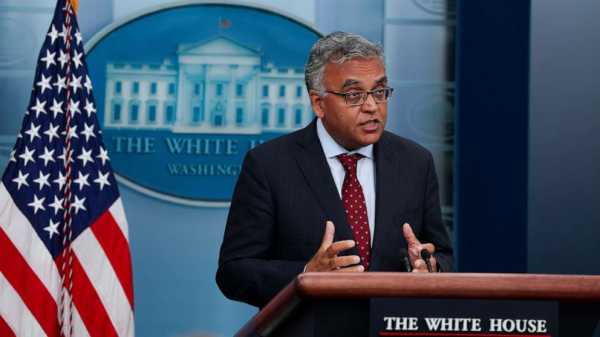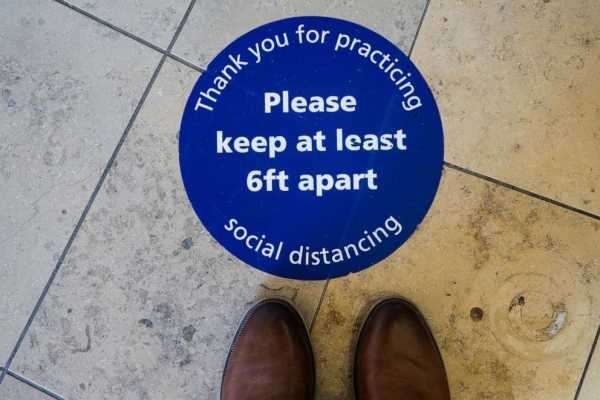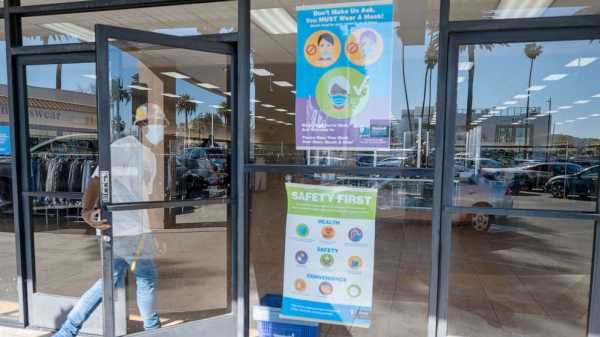Amid the latest COVID-19 resurgence sweeping the nation, some top health officials are asking Americans to wear face masks again in an effort to curb the spread of the virus.
Officials such as White House COVID-19 response coordinator Dr. Ashish Jha and Centers for Disease Control and Prevention Director Dr. Rochelle Walensky have repeatedly encouraged jurisdictions to use the CDC’s community level COVID-19 map, which seeks to identify the risk level of COVID-19 in communities across the country, to help them decide if they should reimplement mitigation measures.
“Local jurisdictions — cities, counties, states — should make decisions about mask mandates because communities are different and their patterns of transmission are different,” Jha told ABC News’ Martha Raddatz last week. “The CDC recommendation is that when you're in a high zone … wearing masks indoors is really important and it really will make a difference.”
According to the CDC, a high community level suggests there is a "high potential for healthcare system strain" and a "high level of severe disease."

White House COVID-19 Response Coordinator Dr. Ashish Jha speaks to reporters during a press briefing at the White House on July 25, 2022.Anna Moneymaker/Getty Images
More than 60% of Americans are now living in a county considered a “high” community level for COVID-19, where masking in indoor settings is therefore recommended by the CDC for all people, no matter their vaccination status.
But calls from the Biden administration’s COVID-19 team have been largely met with silence from local officials, with most cities and jurisdictions choosing to forgo federal guidance.
Although some cities, like Boston and New York City, have released strong recommendations, urging residents to mask again while indoors, no formal mandates have been announced.
MORE: New COVID vaccines expected in fall
In recent weeks, one major U.S. county — Los Angeles — was vocal about a possible return of masking requirements following a steady increase in COVID-19 infections.
However, on Thursday, county health officials announced that with case and hospital admission rates beginning to drop, the return of masking had been scratched.
“Any indication that the committee would soon be moving to the medium community level would be a good reason to not move forward with universal indoor masking, which is what we are doing today,” Barbara Ferrer, the director of Public Health for Los Angeles County, said at a press conference this week. “We will be pausing and not moving forward at this time … the clock is stopped at the moment.”
Some local officials lauded the decision, including L.A. County Supervisor Kathryn Barger.
"Unenforceable mandates don't work," Barger wrote in a statement following the health department’s announcement. "I’m hopeful that we will now be able to move on from this heightened focus on masking mandates to what really matters — focusing on promoting the efficacy of vaccines and boosters, improving access to COVID-19 treatments, and continuing to educate our county’s residents on the benefits of masking.”

Social distancing signage marks the floor in Orange, Calif., April 14, 2022.Orange County Register via Getty Images/FILE
Ferrer stressed that residents are still strongly encouraged to wear masks in many indoor settings and should the numbers begin to rise again, the county will revisit a possible mandate.
“[BA.5] remains highly infectious, so I would strongly advise that everyone keep their masks on when there's risk for that spread,” Ferrer said. “We should be very careful.”
Despite public messaging that “COVID-19 is still with us,” no major states or cities have reintroduced formal mandates. Many Americans have returned to their normal lives without a second thought of pandemic restrictions — a reality that has troubled some health experts.
MORE: Biden compares his COVID recovery to Trump's hospitalization in Rose Garden speech
“I'm concerned about what the lack of restrictions looks like right now. The caseload, which is vastly undercounted, is already creeping up from an unacceptably high plateau of daily cases that has remained in place since the end of the original omicron wave,” Maureen Miller, professor of epidemiology at Columbia University's Mailman School of Public Health, told ABC News.
Experts noted that although the U.S. is certainly in a different place now versus the start of the pandemic, periodic use of mitigation measures could still be a way to control the spread of the virus.
“Interventions shouldn’t be all or nothing. They need to be applied in real-time ahead of any surge to help limit transmission in the community and ultimately reduce severe consequences of the virus and limit hospital capacity,” explained John Brownstein, Ph.D., an epidemiologist at Boston Children's Hospital and an ABC News contributor.

Face mask required sign on the entrance door to a store in Reseda, Calif., Feb. 9, 2022.Los Angeles Daily News via Getty Images, FILE
Policymakers and public health officials should "apply nuance" and "allow for the introduction of targeted intervention” as they consider possible ways to confront the “very likely” fall and winter surge, Brownstein said.
“Surveillance data, when interpreted correctly, should ultimately be the barometer for decisions on bringing back restrictions. Without proactive public health response, we will ultimately just repeat the mistakes of the past,” he added.
In recent weeks, virus-related hospitalizations and deaths have also started to tick up again, though not with the same intensity as previous surges.
MORE: The future of COVID vaccines could be sprays, not shots
"Clearly the lack of current interventions are contributing to a BA.5 surge," Brownstein said. "While we are not seeing the level of severe disease of the past, it is still driving increases in severe disease."
The reality that hundreds of Americans are still dying of COVID-19 every day is not something the public should take lightly, stressed Miller.
“COVID-19 infection is not just like a cold. No cold I know kills 400 people a day,” she said. “With the lack of COVID-19 information from health departments around the country and the blaring message that COVID-19 is over, it will be impossible to convince a fatigued and uninformed public of the need for additional mitigation measures.”
MORE: Long COVID patients turn to ‘blood washing’ procedure
Although there are now many more treatments and tools available to treat Americans should they contract COVID, Miller noted that the simplest and effective tools that were available at the onset of the pandemic remain at the public's disposal: masking and social distancing.
“We experienced the success of this approach in the past. I am doubtful that we will do so in the future,” she said.
The decision not to enforce mitigation measures will only prolong the pandemic, Miller said.
“Our actions are ensuring that the pandemic phase of COVID-19 will last much longer than it has to,” Miller added.
Sourse: abcnews.go.com






